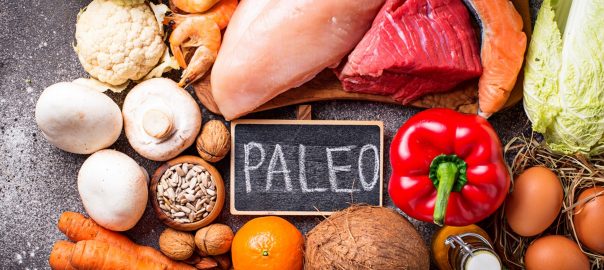
Learn What to Eat on a Paleo Diet
The Paleo Diet. Can You Really Eat Like A Caveman?
Learn whether the paleo diet is sustainable for you and discover tips, recipes and meal ideas to help manage this lifestyle!
Disclaimer: The information in this article is not medical advice. A low carb diet may not be suitable for you. Consult your health care provider before making any changes to your lifestyle or use at your own risk.
The Paleo diet, also known as the “caveman diet,” is based around foods that our ancestors who lived during the Paleolithic era (dating 2.5 million to 10,000 years ago) would have eaten. This includes things like lean meat, wild caught fish, fruits, vegetables, nuts and seeds and excludes foods that emerged with the advent of agriculture such as grains, dairy and legumes.
The philosophy behind this diet is that farmed or processed foods found in modern diets are genetically mismatched with the human body, which evolved during the Paleolithic era on a diet based around food that could only be hunted or scavenged. Whether or not one believes in this philosophy, studies have shown that including more lean proteins and an abundance of fruits and vegetables in the diet can have several health benefits. In addition, we know that many modern food products such as refined carbs, processed meats and dairy, and packaged products are major contributors to the overwhelming prevalence of obesity, diabetes and heart disease in today’s societies.
If you want to take a healthier, more whole foods approach to your diet, some of the principles of the Paleo diet may appeal to you. In addition, if you want to avoid health risks, potentially lose weight, or simply follow a more structured meal plan, then keep reading to learn more about the Paleo diet!
Details of The Paleo Diet
You may already have a general idea of what kinds of foods are allowed on a Paleo diet from the “caveman” term, but below is a complete list of foods you can eat:
- Fruits such as apples, citrus, berries, bananas, grapes, stone fruit, tomatoes, and melons
- Vegetables such as leafy greens, broccoli, cauliflower, mushrooms, carrots, peppers, celery, cucumber, root vegetables, onions and olives
- Poultry and Meat, preferably free-range and grass-fed
- Bacon, preferably nitrate-free
- Game Meat such as quail, goose, duck, rabbit, venison or bison
- Fish and Shellfish, preferably wild-caught
- Nuts and Nut Butter (free of sugars or artificial sweeteners)
- Eggs, preferably fully pastured or free-range
- Healthy Fats such as olive oil, avocado, coconut oil, grass-fed butter or ghee, and chia seeds
- Herbs and Spices
- Natural Sweeteners such as raw honey, coconut sugar, date sugar, maple syrup or sugar-free natural sweeteners such as stevia, monk fruit sweeteners, erythritol and xylitol. Read our article on monk fruit sweeteners for full details.
Although you might imagine our cavemen ancestors gnawing on a drumstick, the real stars of the Paleo diet are all of the fresh fruits and vegetables, healthy fats, and lack of processed foods. It is important to balance out each of your meals with enough fibre, protein and healthy fats. Aim to have about ½ of your plate consist of fruits and vegetables, ¼ protein and the last ¼ can be made up of healthy fats or starchy vegetables.
In addition, drinks allowed on the paleo diet include water, tea, coffee (skip the milk or cream), coconut water, kombucha and unsweetened sparkling water. You may also enjoy gluten-free spirits, organic wine and hard ciders occasionally and in moderation.
Foods and drinks to avoid on the Paleo diet include:
- Pasta
- Bread
- Rice
- Oats
- Quinoa
- White Potatoes (however other starchy vegetables such as sweet potatoes, beets, and squash are permitted)
- Corn
- Legumes such as beans, lentils, soy and peanuts
- Dairy
- Refined sugars
- Refined (or “hydrogenated”) vegetable oils
- Processed, packaged or frozen foods (other than frozen fruit and vegetables)
- Soda and sweetened beverages
- Beer (made from wheat, barley and hops)
As you can tell from this list of foods to avoid, the Paleo diet ends up being relatively low in carbs. This could be good for you if you are trying to cut carbs from your diet, especially refined sugars and carbs found in things like packaged food products, or if you want to manage your blood sugar levels. However, this diet also excludes a lot of foods that have not been scientifically proven to be harmful to our bodies, such as quinoa, oats and legumes. Proponents of the Paleo diet believe that consumption of grains and legumes is linked to chronic digestive problems and inflammatory illnesses; however, there are no scientific studies to back this claim. These foods actually provide lots of nutrients and don’t need to be excluded from the diet unless you have been diagnosed with an autoimmune condition that requires elimination of things like grains and legumes.
Paleo Recipes and Products
Here is what a typical day following a Paleo diet may look like:
Breakfast: Free-range eggs, nitrate-free bacon and fresh berries.
Lunch: Salad with greens, carrots, cucumbers, tomatoes, grilled free-range chicken breast and a lemon-olive oil dressing.
Dinner: Wild-caught salmon with steamed broccoli, cooked sweet potatoes and avocado on the side.
Dessert: Paleo/Keto Chocolate & Coconut Covered Frozen Blueberries (recipe here).
Snacks: Citrus fruit, carrot or celery sticks or a handful of nuts.
This diet also emphasizes drinking lots of water and incorporating a routine of daily exercises – cavemen didn’t sit on the couch all day!
Here are some more Paleo-friendly recipes we found online:
- Bruschetta Grilled Chicken
- 6 Ways to Make Paleo Cauliflower Rice
- Carrot Breakfast Cookies
- Paleo Chili
- Veggie Paleo Pizza (with dairy-free mozzarella and grain-free crust)
- Paleo Burrito Bowl
- Perfect Paleo Granola
If you are looking for products and ingredients to make Paleo cooking and eating easier, see our inventory of low carb, grain-free and paleo-friendly items such as:
- Anthony’s Premium Blanched Almond Flour – a nutritious grain-free substitute for wheat flour to make baked goods, homemade breads, pizza crusts, breadcrumbs and more!
- BUFF Bison Jerky Sticks – higher in protein than beef
- Evolved Vegan, Paleo Chocolate Nut Butter Keto Cups
- Glutenull Bakery Raw Paleo Bars
- Nick’s Sticks 100% Grass-Fed Beef Jerky Snacks
- Nuco Coconut Wraps
- Nud Fud Organic, Vegan, Paleo, Keto Crackers
- Primal Kitchen Salad Dressings and Condiments
- Unbun Vegan, Paleo, Keto Bread, Buns and Pizza Crust
Paleo Diet Tips
The following tips can help make following a Paleo diet a little bit easier. These tips are also useful guidelines for how to include more whole foods in your diet, plan your meals more effectively, and save time cooking. Even if you do not follow a Paleo or other low carb diet, these tips can help you manage your weight and health by simplifying your diet and eating practices.
- Be present when you eat. This sounds cheesy – but it works! You’d be surprised how much we tend to overeat when we’re doing mindless things like watching TV while eating. When you focus on your food and chew thoroughly, you will find you get full much easier.
- Invest in the right kitchen equipment. Things like heavy duty blenders (for hot soups and sauces), food processors, instant pots and slow cookers can make cooking simpler and quicker!
- Use the right cooking oils. We’ve mentioned a few healthy fat sources so far, but it’s worth repeating! Using a healthy omega-3 rich cooking oil such as extra virgin olive oil, grass-fed butter or ghee, and coconut oil is one of the easiest ways to transform your diet. Processed and refined vegetable oils (such as canola oil, soybean oil, peanut oil, corn oil and sunflower oil) are some of the worst culprits contributing to inflammation, obesity and chronic disease. Plus, you’ll get way more flavour out of healthy cooking oils.
- Soups and stews are your friends – these foods are simple and easy ways to incorporate lots of vegetables, herbs, and spices for big flavour and big nutrition, even if you’re no star in the kitchen.
- Make your own condiments. This is a popular tip especially for Paleo dieters because so many store-bought condiments contain things like added sugars, colours and preservatives. See these recipes to learn how to make Paleo Ketchup and Paleo Mayonnaise.
- Plan meals ahead of time. It never hurts to sit down and make a list of meals you know you can cook before going grocery shopping or starting the week ahead. This can help ease decision making on rushed weeknights or when cravings strike. For a Paleo diet, roasting vegetables or cooking a big batch of cauliflower rice at the start of the week can really make putting together quick lunches or dinners that much easier.
- Try fasting. Sometimes our cave-dwelling ancestors had to go long periods of time before their next meal. Fasting actually has several proven health benefits, including helping people lose weight and manage blood sugar levels. Check out our article on
- Keep things simple. The more you complicate your meals, the less “Paleo” they become! Base your meals around whole foods, such as fruits, vegetables and proteins. Cook them in a healthy fat; something like grass-fed butter can add a lot of flavour without much effort. Spice things up or add a few fresh herbs and enjoy the simple goodness of everything nature has to offer!
- Buy organic and seasonal when possible. Organic farming practices bring food as close as possible to their natural state, and it prevents you from consuming toxic chemicals. Seasonal fruits and vegetables also tend to be cheaper and tastier and can help inspire you to make different meals from one season to the next. Check out our guide to seasonal shopping.
- Get outside! Moving your body each day is important for weight loss and general health maintenance. Being in nature also has proven benefits for stress management and daily exposure to sunshine provides us with Vitamin D, one of the most important vitamins that we just don’t get enough of these days!
Who Should Not Try the Paleo Diet?
Before you begin a paleo diet, discuss any underlying health conditions with your doctor to make sure it’s safe for you. For example, those with heart and kidney conditions or who have been diagnosed with type 1 diabetes should avoid this type of diet.
So… Should you eat like a caveman?
The Paleo diet may have some benefits for weight loss, improved glucose tolerance, lower risk of heart disease and better appetite management, but it may not be right for everyone. Furthermore, many of the claims behind the Paleo diet hypothesis have been argued against by researchers that offer a more complex understanding of human evolution. For example, some archaeological research suggests evidence of human consumption of wild grains as much as 30,000 years ago – long before the introduction of farming. In addition, scientists have discovered notable genetic changes since the Paleolithic era such as an increase in the number of genes associated with the breakdown of dietary starches and lactose tolerance. These findings contradict the Paleo diet hypothesis that our genes could not catch up with the sudden and quick surge in farming practices that occurred 10,000 years ago.
Nonetheless, it never hurts to incorporate more fruits, vegetables, healthy fats and lean proteins into your diet and eliminate harmful food products such as refined sugars and carbs. You don’t have to go all-out Paleo, but you can still enjoy some of the simple pleasures and health benefits of unprocessed, whole foods eaten by our ancestors!
Stay Connected
We hope you found some takeaways from this article. If you want to share your experience with us, please feel free to leave a Google Review. Want to join the low-carb, paleo and keto online communities? Follow us on Facebook and Instagram. And, don’t forget to subscribe to our online newsletter for the most up-to-date low-carb and sugar free news, as well as weekly sales!






